
Besides arm steak, this cut goes by a few other names, including chuck steak, arm Swiss steak, round bone steak and round bone Swiss steak. It's an affordable and flavorful but notoriously tough and fatty cut of beef taken from the shoulder. Dry cooking methods like searing, grilling and broiling won't cut it in this instance; the results will be too tough and chewy. Braising an arm steak -- quickly searing it then slowly cooking it for an extended time in a liquid -- turns this trickier cut into a tender, delicious meal.
Step 1
Set your oven to 325 degrees Fahrenheit. Allow it at least 20 minutes to fully preheat.
Step 2
Chop celery, carrots and onion -- together known as a mirepoix -- into small pieces. These aromatics are a standard component of soups, stews and braises.
Step 3
Dry the arm steak with paper towels, as it won't sear nicely if it has water on the surface. Season it with salt and pepper to taste, along with any other herbs or spices you like on steak, such as thyme, garlic powder or chili pepper powder; a pre-mixed dry rub or a mixture like herbs de Provence works, too.
Step 4
Place a Dutch oven or similar style oven-safe pot over medium-high heat for 2 minutes. Add cooking oil and tip the dish back and forth to fully coat the bottom. Lay the arm steak in the dish and sear each side for 2 to 3 minutes, just until well-browned. Set the meat aside on a plate.
Step 5
Pour the mirepoix into the Dutch oven and saute for 4 to 5 minutes, until softened and lightly browned.
Step 6
Deglaze the Dutch oven by pouring in a braising liquid and scraping up the cooked-on, caramelized brown bits from the arm steak with a spatula. Red wine is an excellent braising liquid for beef, but broths, stocks, beer and other liquids work as well. The amount of braising liquid depends on the thickness of the arm steak; add enough to come approximately half way up the side of the steak when it goes back in the dish. Don't immerse the entire steak, as this results in boiled or poached meat that finishes with an off texture and color.
Step 7
Season the wine or other braising liquid with salt, pepper and any of the herbs and spices you rubbed on the arm steak before searing it. Include other complementary seasonings, aromatics or vegetables, if you like, such as soy sauce, shallot, garlic, leeks, citrus zest, brown sugar, bourbon, string beans or chopped pieces of potato. Bring the liquid to a boil.
Step 8
Return the arm steak to the Dutch oven and put the lid on. Put it into the oven, braise for 30 minutes, then turn the meat over. Braise for about 30 minutes more, until the beef is tender enough that it easily pulls apart. Confirm with a meat thermometer that it has reached at least 145 F at center.
Related Articles
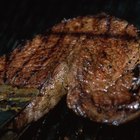
The Best Way to Cook Boneless Shoulder ...
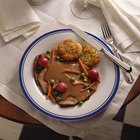
Slow Cooking an Eye of the Round Steak ...

How to Cook Axis Deer Steaks

Arm Roast Vs. Rump Roast

How to Cook a Beef Loin Tri Tip Steak ...

How to Cook Beef Shoulder Muscle
The Best Way to Cook Bison Steak

How to Cook a Rib Eye to Medium-Well in ...

How to Cook Kobe Steaks

How to Cook Pulled Beef Without a Slow ...

How to Cook Center Cut Chuck Steak
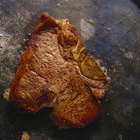
How to Cook Churrasco Steak in a Pan

How to Get Skirt Steak Tender

How to Sear Tenderloin Steak and Cook ...
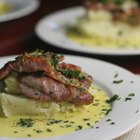
How to Cook Veal Leg Scallopini

How to Cook Pan Fried Deer Tenderloin
Easy Crock-Pot Beef Brisket Recipe
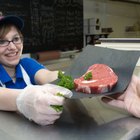
How to Cook Rump Steak
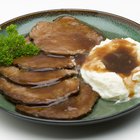
The Best Way to Cook a Boneless Chuck ...

How to Cook London Broil
References
Tips
- You can braise from start to finish over low heat on the stove top if you don't want to use the oven. However, the arm steak is more likely to burn and requires more frequent turning and monitoring. Remember to cover the pan or dish after the meat goes back in.
Warnings
- Arm steak, like all meat, must be stored below 40 F to prevent bacterial overgrowth. Freeze the steak if you aren't going to cook it within 5 days of buying it or by its use-by date.
Writer Bio
Eric Mohrman is a food and drink, travel, and lifestyle writer living in Orlando, Florida. He has professional experience to complement his love of cooking and eating, having worked for 10 years both front- and back-of-house in casual and fine dining restaurants. He has written print and web pieces on food and drink topics for Visit Florida, Orlando Style Magazine, CrushBrew Magazine, Agent Magazine, Dollar Stretcher Magazine, The 863 Magazine and other publications.
Photo Credits
Nick Clements/Photodisc/Getty Images